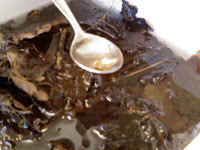Materialen:
- Verzinktes Eisenblech ( 100 cm x 8 cm)
- Klebeband (Breite mind. 2 cm)
- Meterstab
- 2 Petrischalen oder lange dicke Styroporplatte ( 100 x 20 x 5 cm)
- Thermometer oder Pyrometer
- Heißes Wasser ( ca. 60°C )
- Kochsalz/ Eis-Kältegemisch
- Flohkrebse, Hüpferling, Wasserschnecken, Kellerasseln usw. im Hälterungsgefäß
Durchführung:
Herstellung einer Temperaturorgel
Zuerst vermisst man das Blech mit einem Meterstab und macht mit wasserfestem Folienstift einen Strich in der Entfernung vom Rand, an den man mit Klebeband anlegen kann.
Dann werden die Kanten des Bleches mit dem Klebeband längs abgeklebt, damit man sich nicht schneidet.
 Jetzt bringt man einen Strich längs einer Schmalseite in ein paar cm vom Blechrand an.
Jetzt bringt man einen Strich längs einer Schmalseite in ein paar cm vom Blechrand an.
Dann misst man von diesem jeweils 10 cm und macht wieder einen Querstrich.

Schließlich beschriftet man die Flächen zwischen den Strichen mit den Abständen von der ersten Schmalseite: 0- 10 cm, 10- 20 cm, usw...
Dann biegt man mit einer Zange eine Rinne, mit ein paar cm hohen Wänden.
An den Ecken biegt man das Blech an den kurzen Seiten ebenfalls hoch, 
so dass der erste Stricheine Biegekante wird.
Beim Hochbiegen sorgt man dafür, dass keine dunklen Ecken entstehen.
Das Hochbiegen geht besonders gut, wenn man das Blech zwischen zwei Bretter klemmt und dann mit einem Hammer die Ränder runterschlägt.


Beobachtungsaufgaben:
Dann gibt man ein Tier in eine Petrischale oder ein anderes kleines Gefäß.

1.Beschreibe das Tier in Worten:
Wintzig, ähnlich wie Garnelen, viele Füße, wirbellos
2.Beschreibe die Fortbewegungsweise des Tieres:
Die hinteren Füße werden aktiver benutzt.
Das Tier bewegt sich seitlich vorwärts.
Bei Flohkrebsen: Lege nun ein Laubblatt aus dem Gefäß mit den Flohkrebsen zu dem Tier.
3.Wie verändert sich das Verhalten des Tieres?
Das Tier sucht Schutz/ Deckung unter oder auf einem Laubblatt.
4.Was schließt du aus deiner Beobachtung?
Die Tiere sind lichtscheu.
Bei Flohkrebsen: Man entfernt das Laubblatt wieder und gibt auch das Tier wieder zurück in das Hälterungsgefäß.
Ermitteln der Temperaturpräferenz:
 Nun füllt man die eine Petrischale mit heißem Wasser ( ca. 60 °C) und die andere Petrischale mit einem Kochsalz/ Eis-Kältegemisch. Dann stellt man die Rinne mit dem einen Ende auf die Petrischale mit heißem Wasser und mit dem anderen Ende auf die Petrischale mit dem Kochsalz/ Eis- Kältegemisch.
Nun füllt man die eine Petrischale mit heißem Wasser ( ca. 60 °C) und die andere Petrischale mit einem Kochsalz/ Eis-Kältegemisch. Dann stellt man die Rinne mit dem einen Ende auf die Petrischale mit heißem Wasser und mit dem anderen Ende auf die Petrischale mit dem Kochsalz/ Eis- Kältegemisch.
Jetzt misst man die Temperatur des Wassers mit einem Thermometer oder einem Pyrometer jeweils in der Mitte zwischen den Strichen.


Man kann auch in die dicken Styroporplatte zwei Vertiefungen in einer Entfernung anbringen, die der Länge des Bleches entspricht. Dort füllt man heißes Wasser bzw. die Kochsalz/ Eis- Kältemischung ein und legt das Blech so darauf, dass das eine Ende gekühlt und das andere erhitzt wird.
5. Wenn sich ein stabiler Temperaturgradient von mindestens 30°C (z.B. von 0°C bis 30°C)
eingestellt hat, erstellt man eine Wertetabelle in einem Achsenkreuz ( x: Entfernung von einer Seite: 5cm, 15cm, 25cm usw., y: Temperatur). Im Protokoll wird dann ein Schaubild gezeichnet: x- Achse: Entfernung von einer Seite, y- Achse: Temperatur).
Gib dann einen Flohkrebs in die Mitte der Rinne.



 6. Mache alle 5 Sekunden ein Kreuz in die Spalte mit der richtigen Nummer des Segments, in dem sich das Tier gerade aufhält. Führe den Versuch 2 Minuten lang durch. Gib danach das Tier wieder in das Hälterungsgefäß zurück. Erstelle für das Protokoll in MS Excel, in OpenOffice Calc ein Balkendiagramm mit deinem Versuchsergebnis. Führe den Versuch insgesamt mit 5 Tieren jeweils 2 Minuten lang durch und erstelle für jeden Versuch ein Balkendiagramm.
6. Mache alle 5 Sekunden ein Kreuz in die Spalte mit der richtigen Nummer des Segments, in dem sich das Tier gerade aufhält. Führe den Versuch 2 Minuten lang durch. Gib danach das Tier wieder in das Hälterungsgefäß zurück. Erstelle für das Protokoll in MS Excel, in OpenOffice Calc ein Balkendiagramm mit deinem Versuchsergebnis. Führe den Versuch insgesamt mit 5 Tieren jeweils 2 Minuten lang durch und erstelle für jeden Versuch ein Balkendiagramm.

7. Erstelle ein abschließendes Balkendiagramm, in dem du alle Kreuze summierst.
8. Interpretiere deine Ergebnisse.
Von 7 Tieren bevorzugten 4 Tiere das kältere Wasser ( ca. 8 °C), nur 2 Tiere blieben in
einem etwas wärmeren Bereich und ein Tier hat sich immer im Bereich von 20,4 °C
aufgehalten.



















































